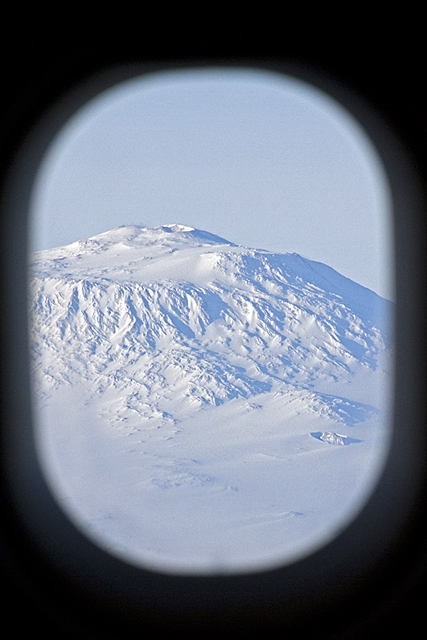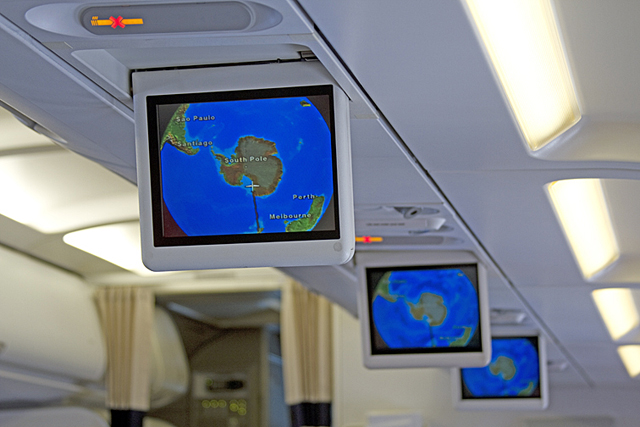
Photo Credit: Cara Sucher |
|
Ready for business
Summer season begins at USAP's McMurdo Station
Posted September 29, 2010

Photo Credit: Cara Sucher
Mount Erebus seen from the Airbus A319.

Photo Credit: Cara Sucher
Airplane monitors show passengers their final destination — Antarctica.
An Australian Antarctic Division  Airbus A319 landed at McMurdo Station
Airbus A319 landed at McMurdo Station  on Sept. 23, officially kicking off the summer field season for the U.S. Antarctic Program (USAP)
on Sept. 23, officially kicking off the summer field season for the U.S. Antarctic Program (USAP)  . The USAP chartered the commercial flight, which made its first visit to the Ice during the 2007-08 field season. The flight took about five hours from Christchurch, New Zealand, and carried 49 passengers. Most support flights from Christchurch are made by the U.S. Air Force from Joint Base Lewis-McChord
. The USAP chartered the commercial flight, which made its first visit to the Ice during the 2007-08 field season. The flight took about five hours from Christchurch, New Zealand, and carried 49 passengers. Most support flights from Christchurch are made by the U.S. Air Force from Joint Base Lewis-McChord  out of Washington State using the C-17 Globemaster III. A second Airbus A319 arrived Sept. 28 after three days of weather delays, along with a C-17. The Antarctic summer field season lasts from October to February. This year promises to be one of the biggest field campaigns in recent memory. Several science teams arrived during Winfly in August for atmospheric studies, as well as research on seal behavior in the winter. [See related article: Ramping up] Summer field camps will again include WAIS Divide in West Antarctica, site of a deep ice core project
out of Washington State using the C-17 Globemaster III. A second Airbus A319 arrived Sept. 28 after three days of weather delays, along with a C-17. The Antarctic summer field season lasts from October to February. This year promises to be one of the biggest field campaigns in recent memory. Several science teams arrived during Winfly in August for atmospheric studies, as well as research on seal behavior in the winter. [See related article: Ramping up] Summer field camps will again include WAIS Divide in West Antarctica, site of a deep ice core project  ; CTAM, for Central Transantarctic Mountains, a single-season large camp focused on fossil collection, geology and paleo reconstructions of the ice sheet; and the Pine Island Glacier (PIG) camp in far West Antarctica, a helicopter camp to be established this season in anticipation of a two-year project
; CTAM, for Central Transantarctic Mountains, a single-season large camp focused on fossil collection, geology and paleo reconstructions of the ice sheet; and the Pine Island Glacier (PIG) camp in far West Antarctica, a helicopter camp to be established this season in anticipation of a two-year project  to study the interaction of water and ice on the underbelly of the heavily crevassed PIG ice shelf.
to study the interaction of water and ice on the underbelly of the heavily crevassed PIG ice shelf.







